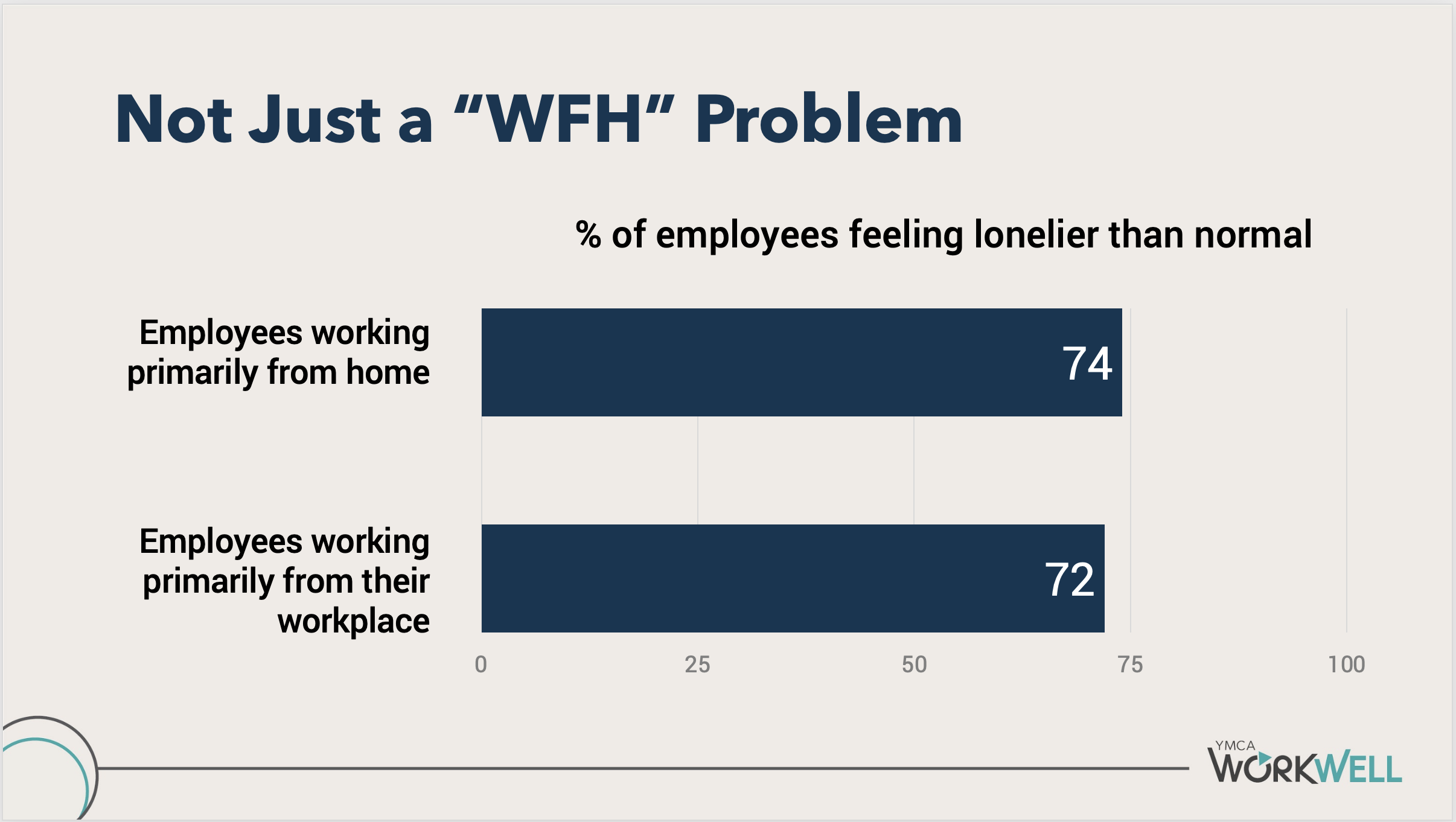Today we hosted our second webinar in our Loneliness Epidemic series focused on loneliness in the workplace:
Key highlights:
- 72% of employees have felt lonelier than normal during Covid-19.
- 79% of employees said that COVID-19 has had a negative impact on their personal well-being.
- 75% of employees believe that feelings of social isolation have had a negative impact on their personal well-being this past year.
Why it matters:
- Social connection is the best and most consistent predictor of a long and happy life (Harvard Study of Adult Development, 2017)
- Loneliness contributes to health problems, reduced productivity, higher turnover and burnout (Hadley, 2021)
- Pre-pandemic, approximately 1 in 4 of us felt lonely (WorkWell, 2019)
- And then COVID hit…


Questions from the attendees:
Q: Have you measured the increase in loneliness between those living on their own vs. those in a relationship/family unit?
A: Single parents, students living with their parents, and those single and living alone were three of the loneliest groups. But those living with their partners really weren’t much better. We’re talking about 68% feeling lonelier than normal vs. 80%.
Q: Was there any data collected on loneliness within the LGBTQ2S+ population? If yes, how did it compare with the overall findings?
A: We did, about 10% of our sample identified as LGBTQ2S+. They were one of the groups with the highest levels of loneliness, as well as the highest need for mental health supports (along with students) and they experienced significantly more mental health challenges in the last year than the average.
We asked our attendees:
What are some things that your organization has done during the pandemic to enhance connection among employees?
- Coffee chats....a set time twice a week, where people can gather their coffee and connect.
- virtual activities! Scavenger hunts, bingo, trivia biweekly on Fridays.
- A walking commute: we have phone conversations with a few of our team members which takes place of our commute time before we start our day.
- Scheduling informal meetings that are simply virtual coffee chats, lunchtime catch up with cross-functional representation- not work-specific!
- Weekly Coffee chats. Random coffee chats with a different individual every two weeks. Regular scheduled meetings during the week.
- We did small group google meets with the explicit purpose of coping with workload and wellness issues, and weekly lunch and learns with our department team and this helped to create connections. We offered an evening virtual "tea and talk" that was pretty well attended.
- Frequent staff meetings with large and small teams, one on one meetings, weekly informal coffee hour chats that are not work oriented
- I was new in December - so felt VERY disconnected - I have the sweetest small team of three and since everything is on Teams, connection didn't expand much beyond meetings, so we initiated team lunch and coffee chats every week.
- Our Employee Resource Groups has been fantastic with setting up monthly fitness virtual fitness classes and virtual cooking classes, and getting us outdoors there on Strava to share our runs/walks/hikes
- We have added some extra touch points that I’d describe as ‘virtual water cooler’ (1-1s, small groups etc)… but very employee-driven. They are suggesting and choosing activities - groups self-organizing and are making bread, crafts, music… whatever they want.
- Leaders facilitating Team Connection sessions with their teams to learn from them together- what would meaningful connection look like in this new hybrid work environment, and then implementing these together as a team (i.e. trivia's hang-out sessions, coffee huddles each morning etc.
- We have shared articles and resources with leaders related to managing remote teams and how to stay connected.
What have we learned that we want to take with us post-COVID?
- Just a general increased level of empathy and compassion for appreciating where people are at
- Flipping the model upside down, a positive I’ve found is that digital has made access to leadership easier… I am (intentionally) spending MORE time with team members I might not usually bump into via the structure of my work. Digital office hours etc. When we return to office, I will keep using digital to improve accessibility/engagement
- Mental Wellness/health literacy
- Taking a “remote first” approach to meetings. If one person in a meeting is remote, everyone should be on their own computers (instead of a conference room)
- If we didn't fully realize it before, the need to be flexible and LISTEN and be responsive to employee needs has really hit home during the pandemic, and want to take forward. not to take these relationships for granted.
- Boundaries! I have stayed above water by prioritizing work-life balance.
- What to take with us- we can do our job in different ways- mental well being and time to re think how we re enter
- projects are involving more people from different departments - cross-functional maturity
- Using multiple modes of communication - video meetings (cameras optional), teams chats/shared documents, supporting/following major meetings with summaries sheets and encouraging managers to share all these verbally. Lots of FAQs- always. Basically- ensuring all our bases are covered to meet everyone’s needs.
- Great work-life balance. The family (young children) also sees how busy you are at work.
- Not assuming that co-workers are okay and trying to connect meaningfully by asking how they are really doing.
- Strongly agree - placing higher priority on informal connection
- For anyone who may find it useful, we start each meeting with "how can I support you this week? what are you nervous about? what are you excited about?". I have found it extremely valuable and a great way to feel supported by my team.